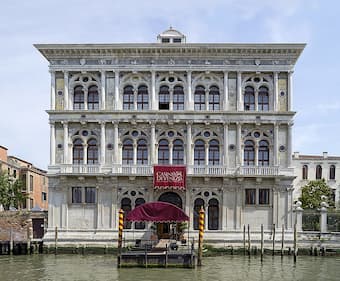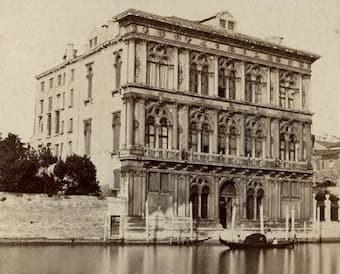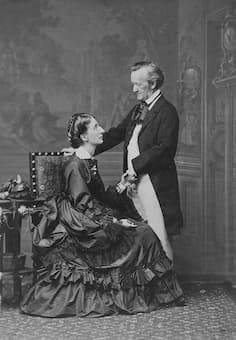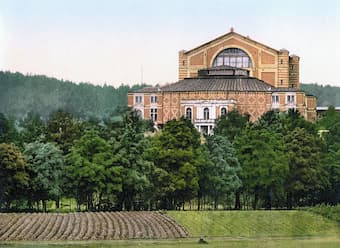
Richard Wagner, 1871
We do know that Richard Wagner died on 13 February 1883 after suffering his final, fatal heart attack. However, there is still much debate as to what triggered that fatal attack. The leading English-language dictionary asserts, “the attack followed an uncharacteristically bitter row with Cosima, which was apparently provoked by the announcement of a visit from one of the Parsifal flowermaidens, Carrie Pringle, with whom it has been alleged Wagner may have been unduly intimate.” Other sources consider this pure fiction, and declare that “the argument with Cosima, and Wagner’s amorous interest in Carrie Pringle, is without credible evidence.”

Ca’ Vendramin Calergi
While the veracity of this anecdote will surely be discussed for decades to come, Wagner took his last breath at Ca’ Vendramin Calergi, a 16th-century palazzo on the Grand Canal in Venice. The city of Venice held special meaning for Wagner, as he first stayed there for seven months in 1858. At that time he wrote, “Venice is a far off world of other times so deeply in harmony with my own desire for solitude. Nothing here has the immediacy of real life. Everything here suggests a work of art. Stay here I shall.”
Richard Wagner: “Flower Maiden in Parsifal”

Venice. Palazzo Vendramin. 1870s
Venice became a personal and creative refuge for Wagner, and he made a total of six trips to the city. When Wagner made his final visit to Venice in the spring of 1882, he confided to Cosima that he’d like to die in Venice. The family initially stayed at the hotel Europa before sub-leasing an entire floor of the palazzo Vendramin Calgeri from Count Bardi. “The apartment was located in the wing overlooking the garden and consisted of 28 rooms, a kitchen and services; Wagner particularly liked to receive guests in the large room, whose double window offered a splendid view of the Grand Canal.” At the end of 1882, Franz Liszt visited his daughter Cosima, and “Liszt and Wagner were often seen sitting together and chatting in front of the large window on the Grand Canal.” Liszt may have had a premonition of Wagner’s death, as he was inspired by the sight of funeral gondolas on the canals to compose the piano piece “La lugubre gondola.” Liszt rewrote the piece in January 1883, and shortly thereafter arranged it for violin or cello and piano.
Franz Liszt: “La lugubre gondola”

Richard and Cosima Wagner
Liszt had traveled to Venice to celebrate the 45th birthday of his daughter Cosima, and Richard Wagner was preparing a concert in honor of his wife. Two days before the birthday concert, during a rehearsal “with an orchestra comprised of Venice Conservatory students and professors, the 69-year-old Wagner suffered a heart attack, one of many in his later life.” However, on Christmas Eve 1882, Wagner gathered his family at the Teatro La Fenice in Venice. Inside the gilded Sale Apollinee, Wagner took the baton for a private concert of his “Symphony in C major,” a work he had composed at the age of 19.

Festspielhaus Bayreuth in 1900
Wagner was able to conduct the first two movements before he had to ask his student and protégé Engelbert Humperdinck to take over. At Wagner’s request, Liszt also played a Rossini aria at the piano. On the night before he died, Wagner supposedly played the Lament of the Rhine Maidens at the piano. On the day of his death, Wagner cried out at 2pm, and while he was taking his last breath, Cosima went to the piano and played. According to the initial examination, “Wagner showed a much-dilated stomach, internal inguinal hernia, much dilated heart, with fatty degeneration. Death occurred directly from rupture of the right ventricle.”
Richard Wagner: Symphony in C Major (Netherlands Radio Philharmonic Orchestra; Edo de Waart, cond.)

Wagner’s grave
A funeral gondola carried Wagner’s remains over the Grand Canal and to the railway station, and from there his body was taken by train to Bayreuth, where he was buried in the garden of the Villa Wahnfried. “Several floral tributes are laid on a flat gravestone that is in the middle of a large bed full of low leafy plants. A crazy-paved path passes either side of the bed, and Cosima’s ashes were placed alongside Wagner’s body in 1977.” Throughout his life, Wagner suffered from “headaches, dyspepsia, nervousness, melancholy, insomnia, and indescribable suffering all the time. He found these symptoms exactly proportioned to the amount of reading, writing and composing that was attempted, and when his eyes were driven to their un-physiologic function the symptoms increased in intensity until life itself was threatened either by the disease or by the despair of the patient.” In fact, shortly after his death, music was seen as a potentially dangerous stimulant for Wagner and for all lovers of his music. As a scholar writes, “Wagner’s music was seen not just as a symptom of the physical and sexual pathologies associated with a nervous modernity – everything from neurasthenia [nervous exhaustion] and degeneration to perversion and fatigue – but also as the direct cause of these.” Friedrich Nietzsche famously asked in his book The Case of Wagner, is “Wagner actually a man? Is he not rather a disease?”
For more of the best in classical music, sign up to our E-Newsletter
Richard Wagner: Rheingold “Rhinemaiden’s Lament”
